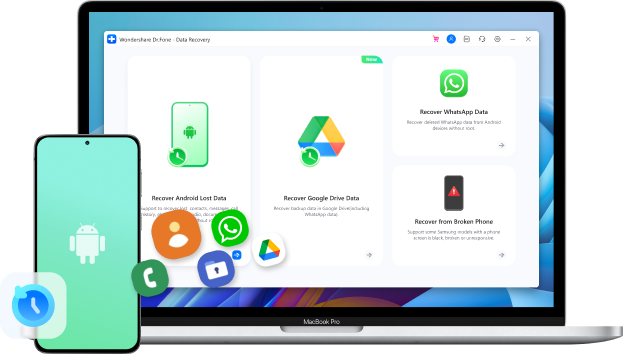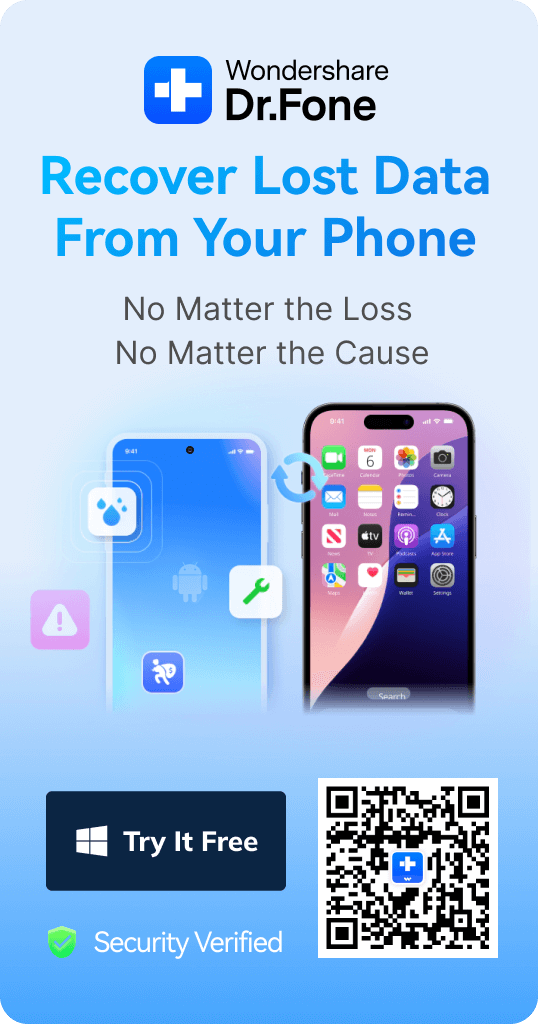
How to Recover Deleted Files from Android Phones and Tablets
Aug 20, 2025 • Filed to: Data Recovery Solutions • Proven solutions
Have you ever confronted the problem where essential data on your mobile disappeared without warning? Users face accidental deletions, system crashes, or formatting errors that can lead to content loss. Losing important files can be incredibly frustrating and anxiety-inducing for many. That is especially true when they hold sentimental or critical professional value.
As a result, learning how to recover deleted files has become crucial for mobile users. However, there’s no need to despair because doing so from Android phones and tablets is easier than you might think. This step-by-step guide will explore multiple recovery options to help you retrieve lost data.

Part 1. Can I Restore Deleted Files from Android?
Losing important content on an Android device can feel overwhelming. However, understanding how data is managed on these devices offers hope for recovery. Hence, let’s explore how Android handles deleted files and what determines your chances of success. In many devices, data is not immediately erased when you erase something.
Instead, the system marks the space they occupy as “available” for reuse, while the actual data remains intact until overwritten. This temporary storage occurs in internal trash folders, system caches, or unused memory sectors.
With the right tools and timely action, the operation to recover deleted files on Android can prove successful. However, the retrieval process heavily relies on acting quickly. The longer the device is used after deletion, the higher the chance of overwriting the data, reducing recovery success rates.
Part 2. How to Restore Deleted Android Files with Backup? Use 3 Methods
Using backups is one of the most reliable and convenient ways to get back lost data, saving time and effort. Be they an intentional backup or an automated one, they can serve as a lifesaver in times of content loss. Explored below are three ways how to recover deleted files from Android effortlessly using backups:
Method 1. Restore from Google Drive
A dependable solution for retrieving lost content, it is the default backup service for Android phones and tablets. As long as you have enabled automatic backup on your device, you will likely find a data backup in Google Drive. It stores messages, contacts, app data, settings, and call history from your device. Follow these steps to check and perform file recovery with ease.
Step 1. On your device, access the Google Drive app and tap the “Three Bars” on the top left corner to select “Backups.” Now, confirm that there exists a backup of your device with the data you are looking to restore.

Step 2. Following that, move to the device settings to access the “About Phone” tab and tap “Reset” for confirmation. Then, opt for “Erase data” after hitting “Factory Data Reset” and provide the phone password to confirm and reset the device.

Step 3. Once you start setting up the device after the reset, the system will detect the available Google Drive backup. Finally, select the desired version and hit “Restore” to initiate the data recovery process.

Method 2. Restore from Local Device Backup
Many Android devices come with their own solutions to ensure your data remains secure. You can utilize these backup options to create and restore backups to restore deleted files when needed. The popular choices include Samsung Smart Switch and Xiaomi’s backup tools. Unlike the Googe Drive option, this backup is much more comprehensive. Adhere to these instructions to use these tools to restore your data:
Step 1. To use Xiaomi’s backup tool, approach the device settings and opt for the “About Phone” tab. Here, scroll downward to tap “Back up and Restore” and choose “Mobile Device” from the “Local” section.

Step 2. Now, provide the device password to access the “Back up” and “Recover” tabs. You will need to have previously created a backup for this approach to work. Finally, move the “Recover” tab to select the targeted backup and hit “Restore” to kickstart the process.

Method 3. Restore from External Cloud Services
When it comes to securing individual files on your Android, many cloud storage options are available for you. Services like OneDrive, Dropbox, Mega, and others are popular choices among users. They contain “Trash” like features for deleted data, adding another security layer. The following steps can help you get back your erased content:
Step 1. Navigate to the Dropbox app on your phone and locate the files you deleted from your device. When you can’t find them but are sure that you stored them on the app, try “Recover deleted files” from the “Account” tab.

Step 2. Here, you can tap “Restore” to move them back to the original location if you find the targeted file. Finally, move to the main location of the data you desire and use “Download” to get them back on your phone.

Part 3. How to Recover Deleted Files from Android with Software/Apps? Use 3 Methods
Where traditional methods like backups or cloud recovery fall short, specialized tools can help you. Using dedicated file recovery apps, you can retrieve lost content directly from your Android. Such apps are designed to scan internal storage and recover lost data efficiently while handling numerous file types. Detailed below are 3 reliable methods to get back deleted files using dedicated recovery options.
Method 1. Use Dr.Fone - Data Recovery (Android) [Safe, Fast & Reliable]
Even among all the content retrieval tools, not everyone yields the desired results. To ensure you can recover deleted files from Android, the recommended option is Dr.Fone - Data Recovery (Android). It is a powerful tool designed to scan each corner of your device to get back what you lost. The program ensures that the recovery process remains non-invasive, keeping your data secure throughout.
Its advanced scanning technology allows users to locate and retrieve files from both internal storage and SD cards. Along with a user-oriented design, this software provides comprehensive support for over 6000 Android devices. What sets Dr.Fone apart is its ability to recover data in accidental deletion, factory resets, or system crashes.
Why Dr.Fone - Data Recovery (Android) Is Ideal for Content Retrieval
- Retrieves lost content from broken Samsung phones and Google Driver to ensure data safety.
- Ensures that no existing data on the device is overwritten or compromised during the recovery process.
- Offers deep scans for recently and older deleted files to recover data from formatted storage.

Dr.Fone - Data Recovery (Android)
Recover Deleted Files from Android
- Easily recover lost data from Android devices & Google Drive
- Recover contacts, SMS, WhatsApp messages and more in one click
- Access 6000+ types of Android devices – no matter the brand
- Highest retrieval rate in the industry.
Detailed Instructions for Recovering Deleted Files from Android via Dr.Fone - Data Recovery (Android)
By offering a high success rate and effortless performance, it continues to be a reliable solution for users. Employ the following step-by-step guide to recover deleted files Windows 10 from Android:
Step 1. Make Your Way to the Data Recovery Menu and Click Recover Android Data
Once you have Dr.Fone - Data Recovery (Android) running and your Android is attached to the computer, approach the "Toolbox" tab. Here, click "Data Recovery" to opt for "Android" as the platform type and choose "Recover Android Data." On the subsequent screen, select the data categories you want to recover and tap "Start Scan."

Step 2. Browse the Recovered Content to Locate Targeted Files
Now, wait for the program to thoroughly scan your device and load all the retrieved data. When done, browse the files to locate what you are looking for and select the desired content. Following that hit “Recover” to choose the desired location and get the files back by pressing “Recover” again.

Method 2. Use Recycle Bin/Trash Apps
In many cases, Android devices store deleted files temporarily in a virtual "Trash" or "Recycle Bin" folder. For instance, Samsung phones include a built-in Recycle Bin feature within their Gallery and My Files app. This method does not need extra tools and helps you recover deleted files from Android internal storage using these steps:
Step 1. Based on what file you lost, access the “Gallery” or “My Files” app on your Samsung device. Now, move to the “Recycle Bin" using the hamburger icon at the bottom right and pick the "Trash" icon.

Step 2. Here, select the targeted file to proceed with the operation. Finally, choose “Restore” or “Restore All” to return the file to the original location.

Method 3. Use Third-Party Recovery Tools
Popular apps like DiskDigger, Disk Drill, and Recuva claim to retrieve deleted data effectively. These tools are often free or affordable, making them accessible to many users. While they can recover content in some cases, their effectiveness varies depending on the device, OS version, and scenario. However, third-party tools may come with limitations that compromise safety and reliability.
Many lack advanced scanning capabilities, like not supporting how to recover deleted contacts on Samsung. Additionally, they may not guarantee secure recovery, unlike Dr.Fone - Data Recovery (Android). That results in increasing the risk of data corruption or incomplete restoration.
Conclusion
In summary, recovering deleted files from Android devices is easier than ever with the right tools and strategies. You can use backups, built-in recycling options, or professional recovery software. At the same time, acting without delay is critical to avoid permanent loss. For effective and comprehensive file recovery, Dr.Fone - Data Recovery (Android) is a leading choice.
While alternatives like Google Drive and local backups provide value, they lack versatility. Accidental deletions don’t have to be the end, as modern tools ensure your data is safe. Trust Wondershare Dr.Fone to recover your valuable files effortlessly for peace of mind.
FAQs
- Photos, audio and videos
- Documents (PDFs, Word files, etc.)
- Contacts and call logs
- Text messages
- App data (e.g., WhatsApp, Messenger)
- Enable automatic backups using Google Drive or other cloud services.
- Regularly transfer important files to secure storage options like external drives.
- Avoid overloading your device’s memory to reduce accidental deletions.
- Be cautious when formatting or resetting your device.
Android Recover
- Recover Apps
- 1. Data Recovery Software for Android
- 2. Top 4 Android Data Recovery Tools
- 3. Restore Deleted Files on Android
- 4. Coolmuster Android Data Recovery
- 5. Guide of Disk Drill for Android
- 6. Android Data Recovery Software
- 7. Gihosoft Android Data Recovery
- 8. Jihosoft Android Phone Recovery
- 9. Minitool Android Mobile Recovery
- 10. Recover Android Data from Fucosoft
- 11. Best Mobile Forensics Tools to Recover Data
- 12. PhotoRec Review
- 13. FoneDog Toolkit
- 14. TWRP Recovery
- Contacts Recover
- 1. Recover Contacts from Stolen phone
- 2. Recover Contacts from Android
- 3. Retrieve Contacts Without Backup
- Files Recover
- 1. Recover Files from Internal Memory
- 2. Recover Miscellaneous Files
- 3. Recover Android's Hidden Files
- 4. Recover Deleted Files from Android
- 4. Recover Deleted Files Without Root
- 5. Recover Files from SD Card
- 6. Undelete Files on Android
- Messages Recover
- Music/Videos Recover
- Photos Recover
- 1. DiskDigger Photo Recover Review
- 2. Recover Deleted Photos from Android
- 3. Recover Photo from Internal Storage
- 4. Recover Photos from Lost Phone
- 5. Restore Android Deleted Photos
- Broken Android Recover
- 1. View Files from Broken Phone Screen
- 2. Recover Data from Dead Phone
- 3. Recover Contacts with Broken Screen
- 4. Recover Text Messages from Android
- 5. Recover Data from Internal Memory
- Social Apps Recover
- 1. Recover Facebook Messages
- 2. Recover WhatsApp Messages
- 3. Recover WhatsApp Messages
- 4. Restore Deleted WhatsApp Messages
- Android Recover Tips
- 1. SD Card Recovery Tools
- 2. Fix Recovery Mode Not Working
- 3. Enter Recovery Mode on Android
- 4. Recover Calendar from Android
- 5. Recover Deleted Call Log on Android
- 6. Clear Cache Partition
- Cloud Storage Tips
- ● Manage/transfer/recover data
- ● Unlock screen/activate/FRP lock
- ● Fix most iOS and Android issues
- Recover Now Recover Now Recover Now



















James Davis
staff Editor